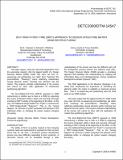| dc.description.abstract | This paper argues, using two real-world applications from
the automotive industry, that the biggest benefit of a Design
Structure Matrix (DSM) model may come not from resequencing
and partitioning, but rather from “rewiring” the
process/blocks. “Rewiring” means redefining relationships
among elements and/or inserting new elements into the
matrix. This requires intimate understanding of the process
and cannot be done with application of context-free
partitioning algorithms.
The Do-it-Right-First-Time (DRFT) approach to DSM
restructuring is another way to look at a DSM by inspecting
the sources of iteration within a block and reversing it through
inserting a DRFT activity at the beginning of the block. In this
way, the traditional Design-Build-Test “Cycle” is reversed into
a DRFT-Design-Build “Sequence." That is, the "wiring
diagram" of a process or system overpowers the behavior of the
individual nodes, so changing the system requires changing
the wiring. | en |
